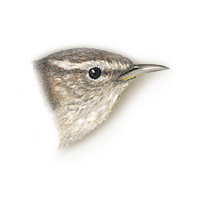 |
Bewick's Wren Thryomanes bewickii |
|
|
STANFORD LOCATIONS: Uncommon to locally common resident virtually throughout campus, occurring primarily in dense patches of brushy vegetation. Distributed fairly sparsely on most of main campus but more common and widespread in woodland and scrub habitats near the Dish and around faculty housing. |
 |
Location |
Type |
Mating System |
Parental Care |
2ndary Diet |
Strategy |
|
|
|
|
I: 12?-14 DAYS ALTRICIAL |
|
|
|
0 - 20 feet + ? |
|
(4-11) MONOG |
MF |
|
| BREEDING: | Open woodland, shrubland, farms, suburbs. >1? brood. |
| DISPLAYS: | ? |
| NEST: | In natural cavity, also amid roots of upturned tree, in variety of other cavities, in center of brushpile; of twigs, grass, lined with feathers, grass. |
| EGGS: | White, flecked with browns, purple, occ wreathed; occ almost unmarked. 0.7" (17 mm). |
| DIET: | Includes spiders. |
| CONSERVATION: | In winter, largely resident but some move s to c Mexico. Uncommon cowbird host. Blue List 1972-86; declining everywhere e of Mississippi River. |
| NOTES: | Male songs show marked geographic variation: males in AZ sing short simple songs but have song repertoires of 15 + songs each; males in CO sing long complex songs but have song repertoires of only ca. 10 songs each; population density, habitat structure, and possibly the vocal milieu associated with avian community composition may influence the nature of geographic variation of songs. Male may build crude "dummy" nests. Occ attack nests of other Bewick's Wrens and of other species nesting nearby. |
| ESSAYS: | Bird Guilds; Blue List; Vocal Development; Vocal Functions. |
| REFERENCES: | Kroodsma, 1985. |
| Help | Abbreviations | Species-Alphabetical | Species-Taxonomic | Essays-Alphabetical | |
| Except for Stanford Locations, the material in this species treatment is taken, with permission, from The Birder's Handbook (Paul Ehrlich, David Dobkin, & Darryl Wheye, Simon & Schuster, NY. 1988). | |||||